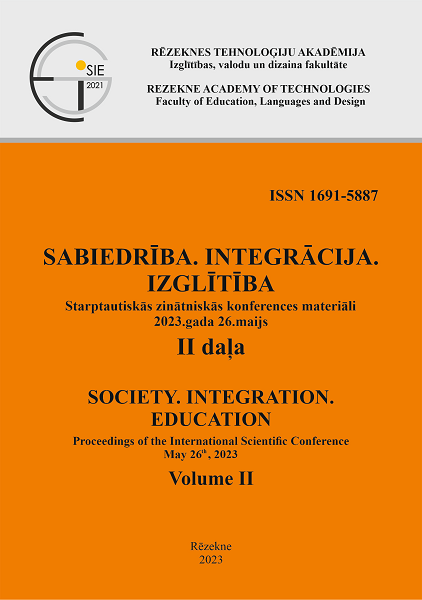THE EFFECTS OF MYOFASCIAL SELF-RELEASE METHOD AND TOOL APPLICATION ON ATHLETE STRENGTH INDICATORS IN TIBIA EXTENSOR MUSCLES IN FITNESS
DOI:
https://doi.org/10.17770/sie2023vol2.7099Keywords:
dynamometry, fitness, maximum strength, myofascial self-release, tibia extensor musclesAbstract
The aim of the present study was to analyse the effectiveness of myofascial self-release methods and the use of the tool in the development of strength indicators in the tibia extensor muscles. Instrumental assessment of muscle function was performed on a REV 9000, Technogymᴿ, Italy. The subjects of our study were twenty healthy fitness athletes aged between 20 and 23 years. A set of strength exercises was developed, consisting of 10 exercises focused on increasing the muscle strength of tibia extensor muscles. For the experimental group self-massage with a roller was applied. When applying strength-development exercises with a set of self-release, the dynamics of maximum strength results are as follows: the force balance of the dominant and the non-dominant leg in the control group before (p=0.001) and after (p=0.02) the experiment, and in the experimental group before (p=0.01) and after (p=0.02) the experiment remained unchanged – no significant changes were observed in the results between the groups; - positive dynamics in strength changes were observed for the dominant leg between the control group (p=0.08) and the experimental group (p=0.37) before and after the experiment. The positive increase in the results is in favour of the experimental group, although there are no significant statistical differences in the results of the control group. On the other hand, no differences in the strength dynamics of the non-dominant leg were found.
References
Aboodarda, S. J., Spence, A. J., & Button, D. C. (2015). Pain pressure threshold of a muscle tender spot increases following local and non-local rolling massage. BMC musculoskeletal disorders, 16(1), 1-10. DOI: 10.1186/s12891-015-0729-5.
Fleckenstein, J., Wilke, J., Vogt, L., & Banzer, W. (2017). Preventive and regenerative foam rolling are equally effective in reducing fatigue-related impairments of muscle function following exercise. Journal of sports science & medicine, 16(4), 474.
Graven‐Nielsen, T., Lund, H., Arendt‐Nielsen, L., Danneskiold‐Samsøe, B., & Bliddal, H. (2002). Inhibition of maximal voluntary contraction force by experimental muscle pain: a centrally mediated mechanism. Muscle & Nerve: Official Journal of the American Association of Electrodiagnostic Medicine, 26(5), 708-712. DOI: https://doi.org/10.1002/mus.10225
Halperin, I., Aboodarda, S. J., Button, D. C., Andersen, L. L., & Behm, D. G. (2014). Roller massager improves range of motion of plantar flexor muscles without subsequent decreases in force parameters. International journal of sports physical therapy, 9(1), 92.
Hill, J., Howatson, G., van Someren, K., Leeder, J., & Pedlar, C. (2014). Compression garments and recovery from exercise-induced muscle damage: a meta-analysis. British journal of sports medicine, 48(18), 1340-1346. DOI: 10.1136/bjsports-2013-092456.
Hunter, A., Watt, J., Watt, V., & Galloway, S. (2006) Effect of lower limb massage on electromyography and force production of the knee extensors. British Journal of Sports Medicine, 40(2), 114-118. DOI: http://dx.doi.org/10.1136/bjsm.2005.019075
Larson, R. (2014) “Customizing the warm-up and cool-down,” in High-Performance Training for Sports (99–112.), eds D. Joyce and D. Lewindon (Champaign, IL: Human Kinetics).
Macgregor, L., Fairweather, M., Bennett, R., & Hunter, A. (2018) The effect of foam rolling for three consecutive days on muscular efficiency and range of motion. Sports medicine- open, 4(1). 1-9. DOI: https://doi.org/10.1186/s40798-018-0141-4
Pearcey, G., Bradbury-Squires, D., Kawamoto, J., Drinkwater, E., Behm, D. & Button, D. (2015) Foam rolling for delayed-onset muscle soreness and recovery of dynamic performance measures. Journal of athletic training, 50(1). 5-13. DOI: https://doi.org/10.4085/1062-6050-50.1.01
Poppendieck, W., Wegmann, M., Ferrauti, A., Kellmann, M., Pfeiffer, M., & Meyer, T. (2016) Massage and performance recovery: a meta-analytical review. Sport. Med. 46, 183–204. DOI: 10.1007/s40279-015-0420-x
Sullivan, K., Silvey, D., Button, D., & Behm, D. (2013) Roller‐massager application to the hamstrings increases sit‐and‐reach range of motion within five to ten seconds without performance impairments. International journal of sports physical therapy, 8(3), 228-236.
Wiewelhove, T., Döweling, A., Schneider, C., Hottenrott, L., Meyer, T., Kellmann, M., ... & Ferrauti, A. (2019). A meta-analysis of the effects of foam rolling on performance and recovery. Frontiers in physiology, 10, 376. DOI: https://doi.org/10.3389/fphys.2019.00376
Zeidlers, I. (2009) Pašmasāža. Izdošanas vieta: “Avots”.
Zorko, N., Škarabot, J., García-Ramos, A., Štirn, I. (2016) The acute effect of self-massage on the short-term recovery of muscle contractile function. J. Kinesiol. Slov. 22, 31–40. ISSN 1318-2269.






